5.3 Walkthrough: Create a Resource Account
After being installed on a computing node, having its credentials defined, and associating itself with the computing node, the Orchestrator Agent begins broadcasting the availability of its host as a potential computing resource. Before the Orchestrator Server can allow an agent to authenticate and establish ongoing communication, you need to create a resource account for the agent on the Orchestrator Server. When this account is created or “registered,” the agent’s host node can be discovered and recognized as a computing resource that can perform the jobs assigned to it.
It is also possible to create a resource account for an agent before that agent is actually installed on a computing node.You can also create a resource account on the Orchestrator Server and have it waiting in an offline state in anticipation of agent installation and login.
This section includes the information you need to create a resource account on the Orchestrator Server:
When resources are created, connected to the Orchestrator Server and online, you will see some jobs deploy and run on their own. For more information, see Section 5.4, Walkthrough: Observe Discovery Jobs Run.
5.3.1 Open the Resources Monitor
Now that you have installed a Orchestrator Server and launched the ZENworks Orchestrator Console, you can begin to create resource accounts.
-
Open the ZENworks Orchestrator Console and click to open the Resources Monitor in the Workspace panel of the console.
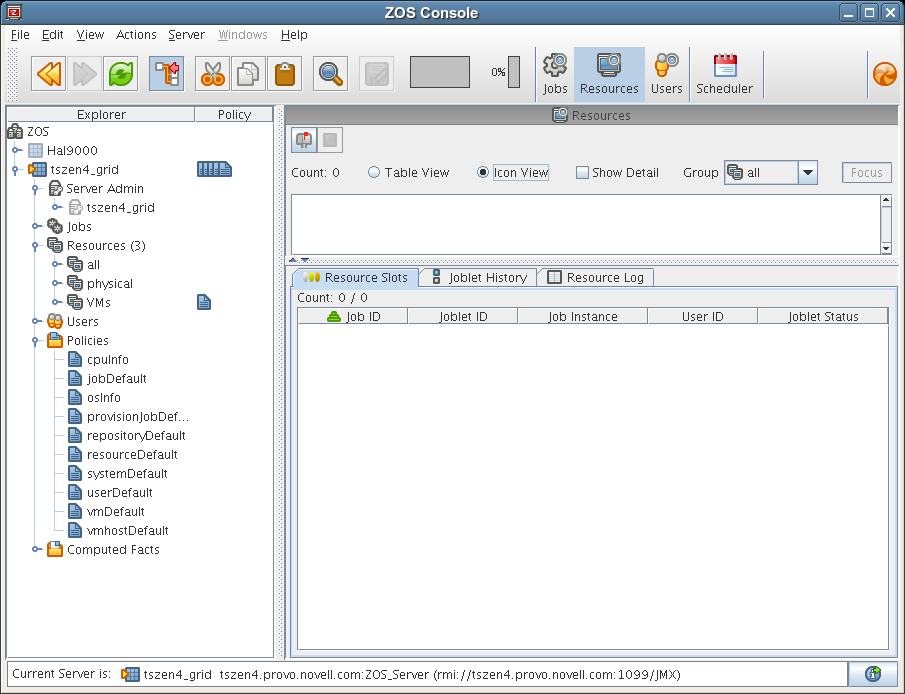
From this monitor, you can see the resources that are connected to the server and what they are doing in the grid.
If an agent is installed but has not been registered (that is, no account is created for it), it attempts a server login every 90 seconds. If this is the case (as in the figure above), the Resource Registration icon has a “flag up” ![]() status, meaning that an agent is waiting to register. If the icon has a “flag down”
status, meaning that an agent is waiting to register. If the icon has a “flag down” ![]() status, either no Orchestrator Agents have been installed in the network or all active agents are logged in, so none are waiting to register.
status, either no Orchestrator Agents have been installed in the network or all active agents are logged in, so none are waiting to register.
You can use the console to register a resource automatically (see Automatically Register a Resource) or to register a resource manually (see Manually Register a Resource). If you choose to, you can also select which agents can log in to create accounts (see Section 5.3.4, Select a Resource for Manual Registration).
The Resources Monitor has many features to help you manage resources when they are registered, including the jobs and joblets assigned to individual resources. For more detailed information about the Resources Monitor, see “Monitoring Server Resources” in the Novell ZENworks Orchestrator 1.3 Administration Guide.
5.3.2 Automatically Register a Resource
If your network environment does not require a high level of security (such as in a development and testing environment) and you want a quick way to create a resource account, you can do so at the console.
-
In the ZENworks Orchestrator console, select the grid object in the Explorer panel to open the page of the grid object.
-
In the section of the page, select the check box. The setting is saved automatically.
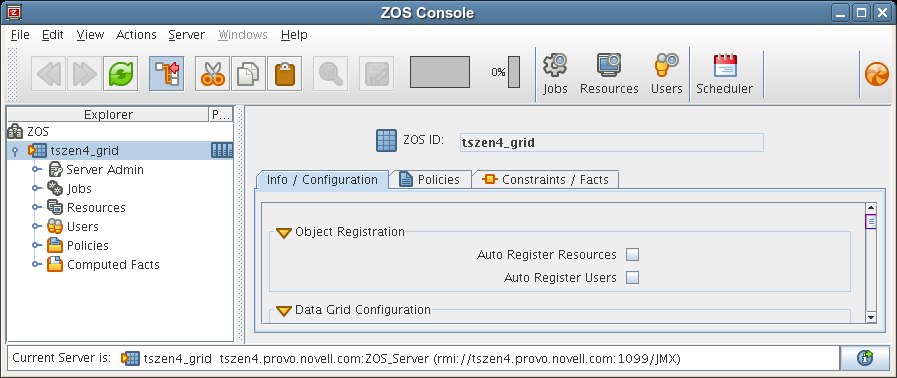
The resource object is created and registered in ZENworks Orchestrator, although offline (the object is dimmed in the tree of the Explorer panel) until it the agent tries to log in.
The next time the agent tries to log in, it is automatically authenticated and ZENworks Orchestrator creates a a new resource account.
When the resource is online, the Resources Monitor displays a labeled box representing the registered agent. This box includes information about the agent, including the number of available slots it has and a status color indicating its state of readiness for Orchestrator jobs.

The status color window can be white (inactive), yellow (available for use), or red (in use). If the color changes from yellow to red, a job is running on this resource. To find out what kind of job is running, you can click the monitor button on the toolbar.
5.3.3 Manually Register a Resource
If you want a higher level of security between the agent and the server, you can manually create a resource account in the console before the Orchestrator Agent is installed. This section walks through both stages of the procedure.
Use the Console to Create a Resource Account
Use the following steps to create a resource object in the ZENworks Orchestrator Console.
-
Make sure that the check box on the grid object’s page is not selected (see Step 2).
-
(Optional) Create a new resource from the Explorer panel in the console.
-
In the Explorer panel in the console, right-click , then click to display the Create a new Resource dialog box.

-
Specify the name of the new resource you want to create in the field, then click .
-
-
(Optional) Create a new resource from the Main Menu in the console.
-
In the console, click > click to display the an expanded version of the Create a new Resource dialog box.
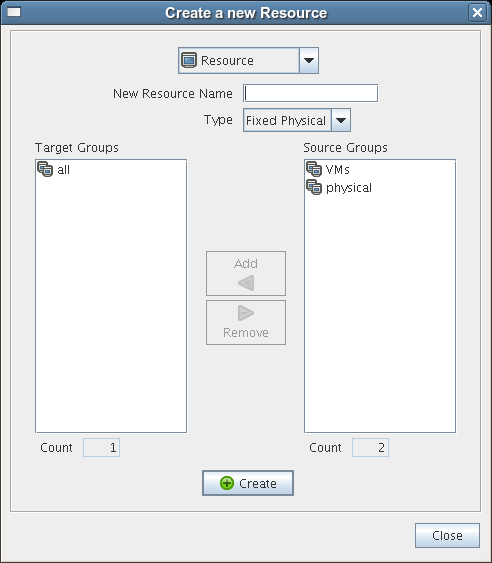
This dialog box includes a method for designating the resource as a fixed physical type or a virtual machine type. It also includes a method for including the resource in various resource groups. In this walkthrough, we will install a Orchestrator Agent on a fixed physical resource and include it in the resource group.
The Virtual Machine resource type is not available if you installed the High Performance Computing license only for ZENworks Orchestrator.
-
Specify the new resource name in the field, then click .
-
Make sure is selected in the drop-down box.
-
In the list box, select the resource group icon, click to move this source group to the list box, click , then click .
The resource account is created, but is offline
 , as indicated by its object icon in the Explorer panel or in the Information view of each resource group to which it belongs. It is not online until an Orchestrator Agent matching the resource is installed.
, as indicated by its object icon in the Explorer panel or in the Information view of each resource group to which it belongs. It is not online until an Orchestrator Agent matching the resource is installed.
-
Install an Orchestrator Agent to Match the New Resource
This section demonstrates installing an Orchestrator Agent to be used as a resource in your Orchestrator grid. The information in this part of the walkthrough assumes that a resource account has already been created for the Orchestrator Agent being installed.
-
From the managed device desktop, launch a browser to access the Web page for ZENworks Orchestrator, as described in Section 4.3.2, Installing the Agent and Clients from the Administrator Information Page (Unsupported).
-
Scroll to the section of the page:
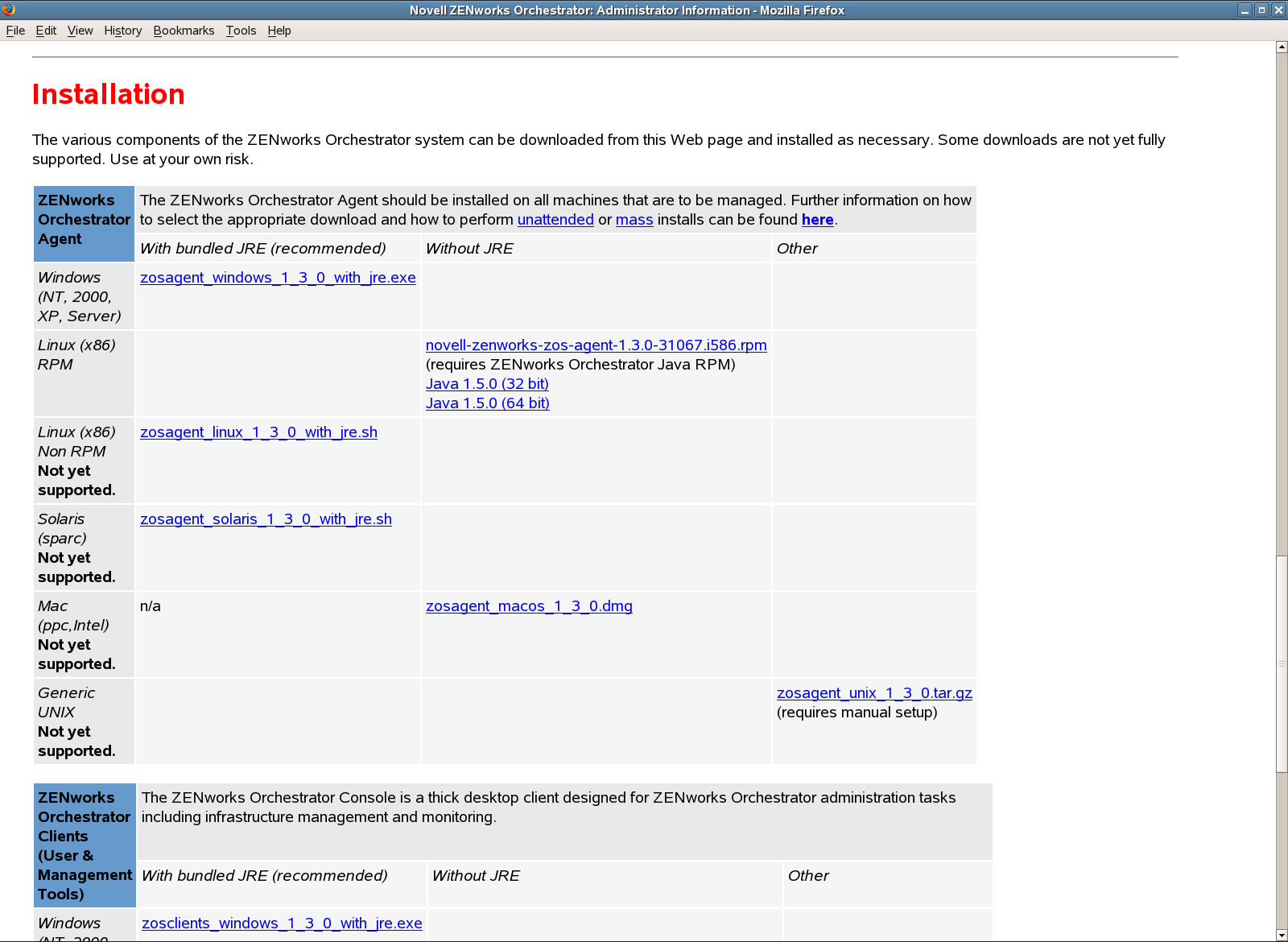
-
In the agent section of the Administrator Information page, identify the installer link for the operating system of the device where you want to install the agent. For this walkthrough, we will install the agent on a Linux operating system.
-
Click the installer link to download the (zosagent_linux_1_1_0_with_jre.sh) to the computing node where you plan to install it.
-
From the machine where you will install the agent (in this walkthrough, a SUSE* Linux 10 SP1 or SP2 machine), open a terminal and navigate to the location where you saved the Orchestrator Agent file, then run the following command:
sh zosagent_linux_1_1_0_with_jre.shThe Orchestrator Agent Setup Wizard is launched.
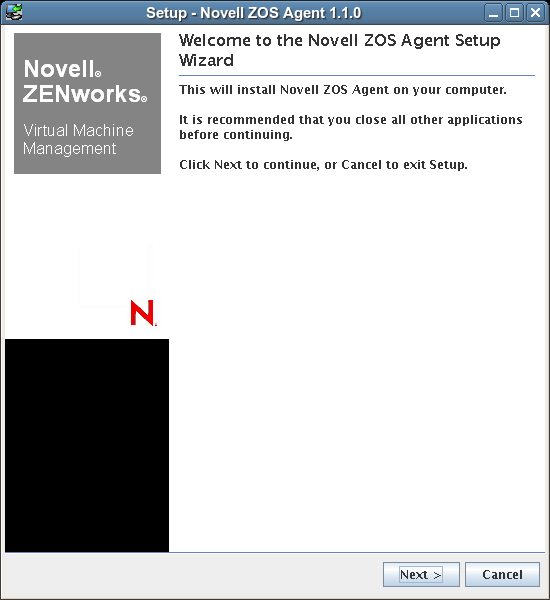
-
Follow the prompts in the wizard until the page displays. Here, you need to ensure that you correctly enter the server_name_for_ZENworks_Orchestrator in the field.
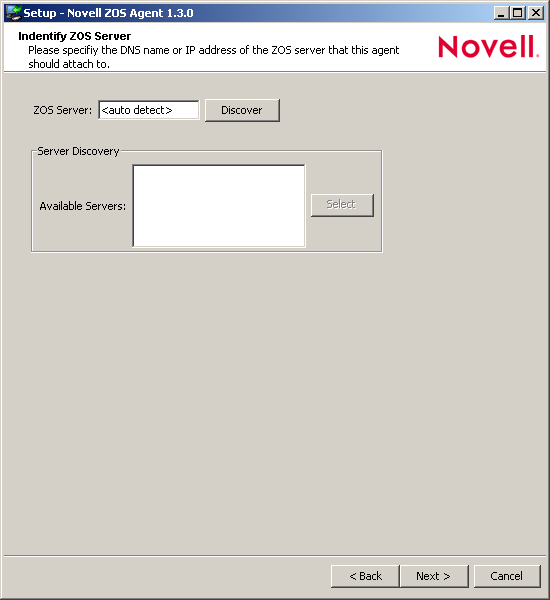
You might find it easier to click so that the installer searches for and finds the Orchestrator Server on the network.
-
Accept the remaining defaults on the wizard pages to complete the installation of the agent.
IMPORTANT:Make sure that the name you give the agent during the installation matches the name of the resource account you created in Use the Console to Create a Resource Account.
-
When the installation is complete, click to exit the wizard.
-
In the ZENworks Orchestrator Console, open the Resources Monitor to observe the resource object you created change from offline to online. When the object is no longer grayed out, the agent has logged in as a resource and is registered.
When the resource is online, the Resources Monitor displays a labeled box representing the registered agent. This box includes information about the agent, including the number of available slots it has and a status color indicating its state of readiness for Orchestrator jobs.

The status color window can be white (inactive), yellow (available for use), or red (in use). If the color changes from yellow to red, a job is running on this resource. To find out what kind of job is running, you can click on the monitor button on the toolbar.
5.3.4 Select a Resource for Manual Registration
If you do not select the check box on the grid object’s page, you have the option of explicitly accepting or denying the login attempts of a resource, thus preventing it from creating an account.
The following steps assume that you have already created a resource in your grid.
-
In the Resources Monitor, click the Resource Registration icon to open the Resource Registration Monitor dialog box.
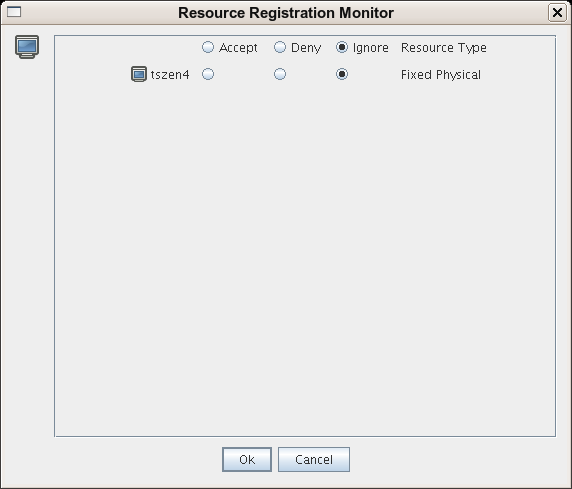
This dialog box lets you preview the Orchestrator Agents that are installed in the network and trying to log in to the server. The top row of radio buttons is a mass selector for all listed agents, allowing you the choice to accept, deny, or ignore automatic registration for all agents, both those currently listed and those that might try to log in later.
If you want to choose the agents that can be allowed to auto register, you can visually identify the agent by name and select how you want to handle that agent’s request for registration the next time it tries to log in.
-
For this example, select the radio button adjacent to the agent you want to register, then click .
-
From the ZENworks Orchestrator Console, open the Resources Monitor to observe the resource object you created change from offline to online. When the object is no longer dimmed, the agent has logged in as a resource and is registered.
When the resource is online, the Resources Monitor displays a labeled box representing the registered agent. This box includes information about the agent, including the number of available slots it has and a status color indicating its state of readiness for Orchestrator jobs.

The status color window can be white (inactive), yellow (available for use), or red (in use). If the color changes from yellow to red, a job is running on this resource. To find out what kind of job is running, you can click on the monitor button on the toolbar.